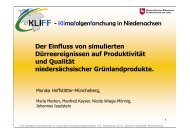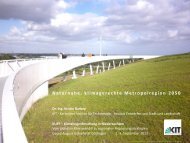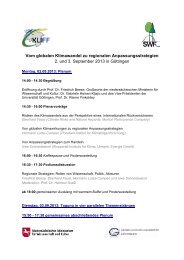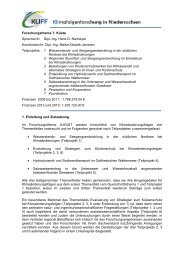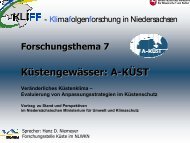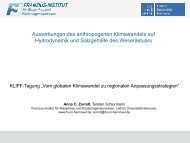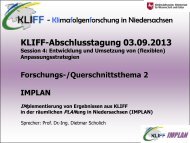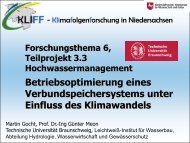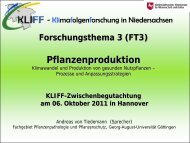Abstract-Band KLIFF-Tagung 2.und 3.9.13
Abstract-Band KLIFF-Tagung 2.und 3.9.13
Abstract-Band KLIFF-Tagung 2.und 3.9.13
Erfolgreiche ePaper selbst erstellen
Machen Sie aus Ihren PDF Publikationen ein blätterbares Flipbook mit unserer einzigartigen Google optimierten e-Paper Software.
Thema 3: Auswirkungen auf Pflanzen, Tiere und Ökosystemesires for different THI points. The evaluation of genomic breedingstrategies is based on the possibility of setting up a calibrationgroup of cows for scarcely recorded phenotypes. In this contextand as a further extension, longitudinal data analyses allow theprediction of genomic breeding values for environments that arepoorly represented in a dataset, e.g. genomic breeding values fortraits at the extreme ends of the THI-scale. We clearly show thatonly a small fraction of phenotyped cows (~ 20%) in environmentsrepresenting heat stress (= THI 75) is required to predict reliablegenomic breeding values in the trait of interest. This might be thecase when exporting livestock from Lower Saxony to tropical countries.A multitude of cows or heifers have genomic breeding valuesfor the moderate THI-range, but only a few cows have phenotypesin environments representing heat stress. Prediction of genomicbreeding values was accomplished for different genetic architecturesof traits, e.g. low versus high linkage disequilibrium (LD),and for different scenarios of natural selection (e.g. bottlenecksresulting in a small effective population size) and artificial selectionstrategies (e.g. changes of the mating system). Furthermore,the effect of the size of the SNP-chip (5 K low density versus 50 Khigh-density) was investigated on accuracies of genomic breedingvalues. Even for low LD and a low density 5K SNP chip, the averageaccuracy of prediction of genomic breeding values in extremeenvironments was 0.52, provided that 20% of cows have phenotypicrecords.Dairy cattle, genotype by environment interactions, breedingstrategiesAuswirkungen steigender Winterbodentemperaturen aufden Abbau von Ernteresiduen, pilzliche Pflanzenpathogeneund die mikrobielle ZersetzergemeinschaftStefan Lukas 1) , Magdalena Siebold 2) , Andreas von Tiedemann 2) ,Sayed Jaffar Abbas 3) , Petr Karlovsky 3) , Martin Potthoff 3) ,Rainer Georg Jörgensen 1)1)Universität Kassel, Fachgebiet Bodenbiologie und Pflanzenernährung2)Georg-August Universität Göttingen, Fachgebiet für Pflanzenpathologieund -schutz99



